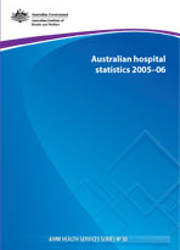Summary
Australian hospital statistics 2005–06 is the thirteenth annual report on the characteristics and activity of Australia’s hospitals. Hospitals included in the report include public acute care and psychiatric hospitals, public non-acute hospitals, private free-standing day hospital facilities and other private hospitals.
This report describes information on a variety of aspects of Australia’s hospital services, including admitted patient care, elective surgery waiting times, non-admitted emergency department care, outpatient care, and public hospital expenditure and resources.
Admitted patient care
During 2005–06, there were 7.3 million separations from Australian hospitals accounting for over 24.3 million patient days, compared to 7.0 million separations and 23.8 million patient days in 2004–05. The majority of separations (61%) and patient days (67%) were from public acute hospitals. Most separations were for same-day care (55%). The average length of stay for all hospitals has decreased by 21.4% between 1996–97 and 2005–06 from 4.2 days to 3.3 days. In 2005–06 for public acute hospitals, the average length of stay was 3.7 days; in private hospitals it was 2.6 days.
In 2005–06, 37.4% of separations had a principal diagnosis that derived from one of five groups of conditions: Diseases of the digestive system; Neoplasms; Diseases of the circulatory system; Pregnancy, childbirth and the puerperium; and Injury and poisoning. The National Health Priority Areas were represented by some high-volume diagnoses. There were over 164,000 separations with a principal diagnosis of fracture; almost 38,000 separations with a principal diagnosis of asthma; and over 57,000 with chronic obstructive pulmonary disease. There were almost 85,000 separations with a principal diagnosis of arthritis and almost 78,000 with a principal diagnosis of angina pectoris.
Females accounted for 53% of hospital separations with a separation rate of 377 per 1,000 compared to 338 per 1,000 for males. Indigenous Australians had high rates of hospitalisation with a separation rate of 623 per 1,000 population compared to 360 per 1,000 for other persons (noting that the Indigenous status data need improvement).
Waiting times for elective surgery
In 2005–06, there were almost 557,000 admissions for elective surgery reported to the National Elective Surgery Waiting Times Data Collection. The median waiting time for elective surgery in public hospitals was 32 days. Cardio-thoracic surgery had the shortest median waiting time (12 days); Ophthalmology had the longest median waiting time (69 days). Approximately 4.6% of people admitted for elective surgery from the elective surgery waiting lists had waited more than 365 days.
Emergency department care
In 2005–06, there were approximately 6.3 million accident and emergency department occasions of service provided in Australia’s public hospitals. Of those occasions of service for which triage category and waiting times data are available (approximately 4.9 million presentations), 69% were seen within the time specified as appropriate for their triage category. In Principal referral and Specialist women and children’s hospitals, the proportion seen on time was 65%, in Large hospitals the proportion was 73%.
Outpatient activity
Excluding services in emergency departments, there were approximately 38 million non- admitted patient occasions of service in public hospitals during 2005–06. Approximately 15 million of these occasions of service were in outpatient clinics. Of those outpatient episodes for which clinic-level information was available (approximately 11.4 million episodes), 2.4 million were occasions of service in Allied health clinics, and 2.1 million were in Medical clinics. Records were also provided for approximately 129,000 group occasions of service. Approximately 83,000 of these group sessions occurred in Allied health clinics.
Hospital resources and expenditure
In 2005–06, Australia had 736 public acute hospitals, 19 public psychiatric hospitals, 252 private free-standing day hospital facilities and 284 other private hospitals. In 2005–06, there were almost 82,000 available hospital beds in Australia, with almost 55,000 available beds in public acute and psychiatric hospitals and over 27,000 available beds in private hospitals. The number of available beds in public acute hospitals decreased by an average of 0.3% annually, and the number of available beds/chairs in private free-standing day hospital facilities increased by an average of 6.0% annually, between 1996–97 and 2005–06.
The number of full-time equivalent staff in public acute and public psychiatric hospitals increased by an average of 2.7% between 1996–97 (174,695) and 2005–06 (221,379). The number of salaried medical officers increased by an average of 5.4% per year over that period (from 14,210 full time equivalents to 22,858).
Recurrent expenditure on public acute and public psychiatric hospitals was $23,991 million in 2005–06, 5.6% greater than expenditure in 2004–05 after adjusting for inflation. Salary payments accounted for 62.1% of total recurrent expenditure in 2005–06, and Medical and surgical supplies accounted for 9% of total recurrent expenditure. The average cost per separation was $3,698 excluding depreciation and $3,839 including depreciation.



